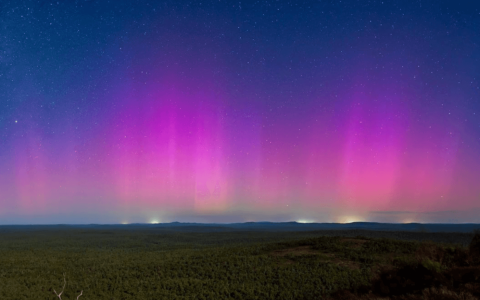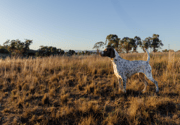Witness the Wonders of Australia's Night Sky: Incredible Southern Lights Illuminate the Country
- Replies 4
Members, prepare to have your minds blown! The Southern Lights, also known as Aurora Australis, have been putting on a spectacular show recently that's leaving onlookers awestruck.
With colours ranging from dazzling greens to dreamy pinks and purples, this natural wonder is putting on a stunning display that's nothing short of mesmerising.
But did you know that it's not just the usual hotspot of Tasmania that is getting a glimpse of this incredible sight? Aussies across the mainland have been reporting sightings of the aurora right from their backyards!
From the western plains of Dubbo to the sunny shores of Lancelin in Western Australia, the Northern Lights' lesser-known cousin has been stealing the show down under.
(Fun fact: In the northern hemisphere, the auroras are called the Aurora Borealis and here in Australia, the auroras are called Aurora Australis.)
Credit: Gippsland Aurora & Astro Photography.
The Aurora Australis was so mind-blowing that it left even the experts at Perth Observatory in awe. In a Facebook post, the Perth Observatory described the display as beating last week's already impressive spectacle.
They went on to explain the science behind the incredible show, which was triggered by a magnetic filament connected to sunspot AR3229 that erupted on February 24th.
What took the aurora to the next level was a partially earth-directed Coronal Mass Ejection (CME), which caused a chain reaction of events that resulted in a stunning light show lasting over 16 hours.
These CMEs are blasts of charged plasma from the sun's outer layers, which travel much slower than flares and can cause beautiful auroras – as well as headaches for some radio and satellite operators.
Reports flooded in from all over Perth, as far away as Lancelin and Kalgoorlie, with people sharing photos and describing with wonder what they were able to see from their backyards.
The skies were painted in vivid hues of green, pink, and purple, with the iconic Southern Cross constellation providing a stunning backdrop.
While many needed a camera to capture the full beauty of the display, some were lucky enough to witness it firsthand. One person wrote, 'Wow! I was hanging out the washing & thought the sunset was hanging around!'
Meanwhile, photographer Scott McDonald was still in shock at what he witnessed in Lancelin, over 125 km north of Perth.
'It is not very often you get the southern lights this strong,' he wrote. 'To see it from Western Australia was just crazy, and it will be hard to sleep tonight – what a rush!'
Another photographer, Vicki Louise, captured her first-ever aurora and was completely overwhelmed by the experience.
'Well, I didn't have this on the 2023 bingo card, but here we are,' she wrote. 'This was shot at Mount Dale & yes, I am completely overwhelmed at the significance of the name – just an hour east of my house.'

According to Perth Observatory, the best places to see the Southern Lights in Perth were Lake Leschenaultia in Chidlow and North Ledge Lookout at Mundaring Weir. But with reports of sightings from all over southern Australia, it seems that this incredible display of natural beauty was visible to many lucky individuals.
If you are willing to try looking for southern lights, here are some factors to keep in mind, according to Australian Geographic:
Location: Head as far south as you can. Tasmania provides the best opportunities, but Victoria, southern NSW, and the most southerly parts of SA and WA are occasionally treated to sight.
A clear horizon: So that your view isn't obscured by trees or buildings, pick somewhere with a clear horizon, such as a south-facing coastline.
Avoid light pollution: The relatively low-intensity aurorae seen from our latitudes are easily drowned out by city lights. Choose a site far from artificial light sources and with no artificial sky-glow to the south.
Freedom from moonlight: Moonlight can also dilute an auroral display, so choose a time when the Moon's phase is between the third quarter and the new. Aurorae can be seen at any time during the night, but the best displays are often seen between 8 pm and 2 am. Long winter nights provide the best opportunities.
Technology: Websites such as space weather com or aurora-service.net provide forecasts of auroral activity, and several Facebook pages offer aurora alerts. It's worth practising night-time landscape photography to perfect the technique of recording low light levels. Auroral colours can be subdued to the eye, but show up well in digital photographs.

This phenomenon is truly one of the wonders of our world, and we feel incredibly lucky to have experienced it here in Australia.
Members, have you ever seen the Aurora Australis in all its glory? Share your stories and experiences with us in the comments below!
And for those of you wanting to try and catch a glimpse of the Southern Lights for yourself, we recommend checking the Bureau of Meteorology's website to find out more. They regularly post updates and forecasts on the Aurora Australis should it appear again in the near future.
Keep your eyes on the sky and fingers crossed!
With colours ranging from dazzling greens to dreamy pinks and purples, this natural wonder is putting on a stunning display that's nothing short of mesmerising.
But did you know that it's not just the usual hotspot of Tasmania that is getting a glimpse of this incredible sight? Aussies across the mainland have been reporting sightings of the aurora right from their backyards!
From the western plains of Dubbo to the sunny shores of Lancelin in Western Australia, the Northern Lights' lesser-known cousin has been stealing the show down under.
(Fun fact: In the northern hemisphere, the auroras are called the Aurora Borealis and here in Australia, the auroras are called Aurora Australis.)
Credit: Gippsland Aurora & Astro Photography.
The Aurora Australis was so mind-blowing that it left even the experts at Perth Observatory in awe. In a Facebook post, the Perth Observatory described the display as beating last week's already impressive spectacle.
They went on to explain the science behind the incredible show, which was triggered by a magnetic filament connected to sunspot AR3229 that erupted on February 24th.
What took the aurora to the next level was a partially earth-directed Coronal Mass Ejection (CME), which caused a chain reaction of events that resulted in a stunning light show lasting over 16 hours.
These CMEs are blasts of charged plasma from the sun's outer layers, which travel much slower than flares and can cause beautiful auroras – as well as headaches for some radio and satellite operators.
Reports flooded in from all over Perth, as far away as Lancelin and Kalgoorlie, with people sharing photos and describing with wonder what they were able to see from their backyards.
The skies were painted in vivid hues of green, pink, and purple, with the iconic Southern Cross constellation providing a stunning backdrop.
While many needed a camera to capture the full beauty of the display, some were lucky enough to witness it firsthand. One person wrote, 'Wow! I was hanging out the washing & thought the sunset was hanging around!'
Meanwhile, photographer Scott McDonald was still in shock at what he witnessed in Lancelin, over 125 km north of Perth.
'It is not very often you get the southern lights this strong,' he wrote. 'To see it from Western Australia was just crazy, and it will be hard to sleep tonight – what a rush!'
Another photographer, Vicki Louise, captured her first-ever aurora and was completely overwhelmed by the experience.
'Well, I didn't have this on the 2023 bingo card, but here we are,' she wrote. 'This was shot at Mount Dale & yes, I am completely overwhelmed at the significance of the name – just an hour east of my house.'

The Aurora Australis has been brighter and more vibrant of late and even outdid the glorious spectacle of last Tuesday. Credit: Instagram/vlwphotography.
According to Perth Observatory, the best places to see the Southern Lights in Perth were Lake Leschenaultia in Chidlow and North Ledge Lookout at Mundaring Weir. But with reports of sightings from all over southern Australia, it seems that this incredible display of natural beauty was visible to many lucky individuals.
If you are willing to try looking for southern lights, here are some factors to keep in mind, according to Australian Geographic:
Location: Head as far south as you can. Tasmania provides the best opportunities, but Victoria, southern NSW, and the most southerly parts of SA and WA are occasionally treated to sight.
A clear horizon: So that your view isn't obscured by trees or buildings, pick somewhere with a clear horizon, such as a south-facing coastline.
Avoid light pollution: The relatively low-intensity aurorae seen from our latitudes are easily drowned out by city lights. Choose a site far from artificial light sources and with no artificial sky-glow to the south.
Freedom from moonlight: Moonlight can also dilute an auroral display, so choose a time when the Moon's phase is between the third quarter and the new. Aurorae can be seen at any time during the night, but the best displays are often seen between 8 pm and 2 am. Long winter nights provide the best opportunities.
Technology: Websites such as space weather com or aurora-service.net provide forecasts of auroral activity, and several Facebook pages offer aurora alerts. It's worth practising night-time landscape photography to perfect the technique of recording low light levels. Auroral colours can be subdued to the eye, but show up well in digital photographs.
Key Takeaways
- Photographers and stargazers across southern Australia have spotted stunning displays of aurora australis from their hometowns on the mainland.
- There were reports of the aurora as far north as Dubbo, New South Wales and Lancelin, Western Australia.
- The Perth Observatory raved about the southern lights in a post on its Facebook page, saying it even beat the spectacle that wowed stargazers last week.
- The aurora was visible to the human eye, but many noted they needed a camera to pick up the colours.
Members, have you ever seen the Aurora Australis in all its glory? Share your stories and experiences with us in the comments below!
And for those of you wanting to try and catch a glimpse of the Southern Lights for yourself, we recommend checking the Bureau of Meteorology's website to find out more. They regularly post updates and forecasts on the Aurora Australis should it appear again in the near future.
Keep your eyes on the sky and fingers crossed!







